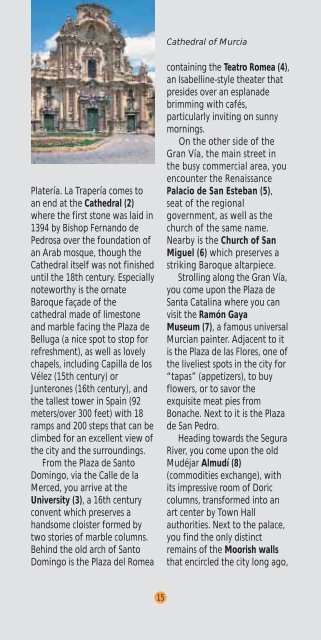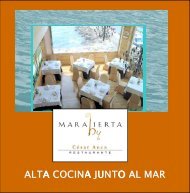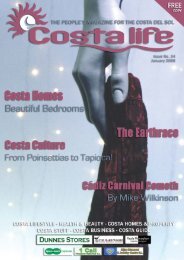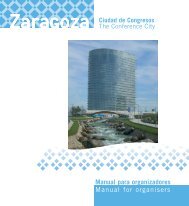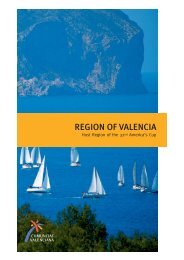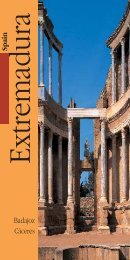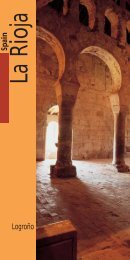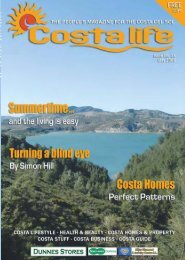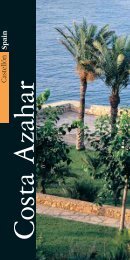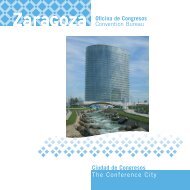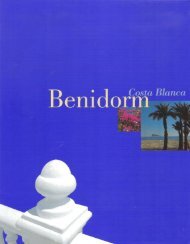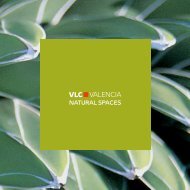Spain - Tourism Brochures and Travel Guides of National, Regional
Spain - Tourism Brochures and Travel Guides of National, Regional
Spain - Tourism Brochures and Travel Guides of National, Regional
You also want an ePaper? Increase the reach of your titles
YUMPU automatically turns print PDFs into web optimized ePapers that Google loves.
Platería. La Trapería comes to<br />
an end at the Cathedral (2)<br />
where the first stone was laid in<br />
1394 by Bishop Fern<strong>and</strong>o de<br />
Pedrosa over the foundation <strong>of</strong><br />
an Arab mosque, though the<br />
Cathedral itself was not finished<br />
until the 18th century. Especially<br />
noteworthy is the ornate<br />
Baroque façade <strong>of</strong> the<br />
cathedral made <strong>of</strong> limestone<br />
<strong>and</strong> marble facing the Plaza de<br />
Belluga (a nice spot to stop for<br />
refreshment), as well as lovely<br />
chapels, including Capilla de los<br />
Vélez (15th century) or<br />
Junterones (16th century), <strong>and</strong><br />
the tallest tower in <strong>Spain</strong> (92<br />
meters/over 300 feet) with 18<br />
ramps <strong>and</strong> 200 steps that can be<br />
climbed for an excellent view <strong>of</strong><br />
the city <strong>and</strong> the surroundings.<br />
From the Plaza de Santo<br />
Domingo, via the Calle de la<br />
Merced, you arrive at the<br />
University (3), a 16th century<br />
convent which preserves a<br />
h<strong>and</strong>some cloister formed by<br />
two stories <strong>of</strong> marble columns.<br />
Behind the old arch <strong>of</strong> Santo<br />
Domingo is the Plaza del Romea<br />
15<br />
Cathedral <strong>of</strong> Murcia<br />
containing the Teatro Romea (4),<br />
an Isabelline-style theater that<br />
presides over an esplanade<br />
brimming with cafés,<br />
particularly inviting on sunny<br />
mornings.<br />
On the other side <strong>of</strong> the<br />
Gran Vía, the main street in<br />
the busy commercial area, you<br />
encounter the Renaissance<br />
Palacio de San Esteban (5),<br />
seat <strong>of</strong> the regional<br />
government, as well as the<br />
church <strong>of</strong> the same name.<br />
Nearby is the Church <strong>of</strong> San<br />
Miguel (6) which preserves a<br />
striking Baroque altarpiece.<br />
Strolling along the Gran Vía,<br />
you come upon the Plaza de<br />
Santa Catalina where you can<br />
visit the Ramón Gaya<br />
Museum (7), a famous universal<br />
Murcian painter. Adjacent to it<br />
is the Plaza de las Flores, one <strong>of</strong><br />
the liveliest spots in the city for<br />
“tapas” (appetizers), to buy<br />
flowers, or to savor the<br />
exquisite meat pies from<br />
Bonache. Next to it is the Plaza<br />
de San Pedro.<br />
Heading towards the Segura<br />
River, you come upon the old<br />
Mudéjar Almudí (8)<br />
(commodities exchange), with<br />
its impressive room <strong>of</strong> Doric<br />
columns, transformed into an<br />
art center by Town Hall<br />
authorities. Next to the palace,<br />
you find the only distinct<br />
remains <strong>of</strong> the Moorish walls<br />
that encircled the city long ago,


